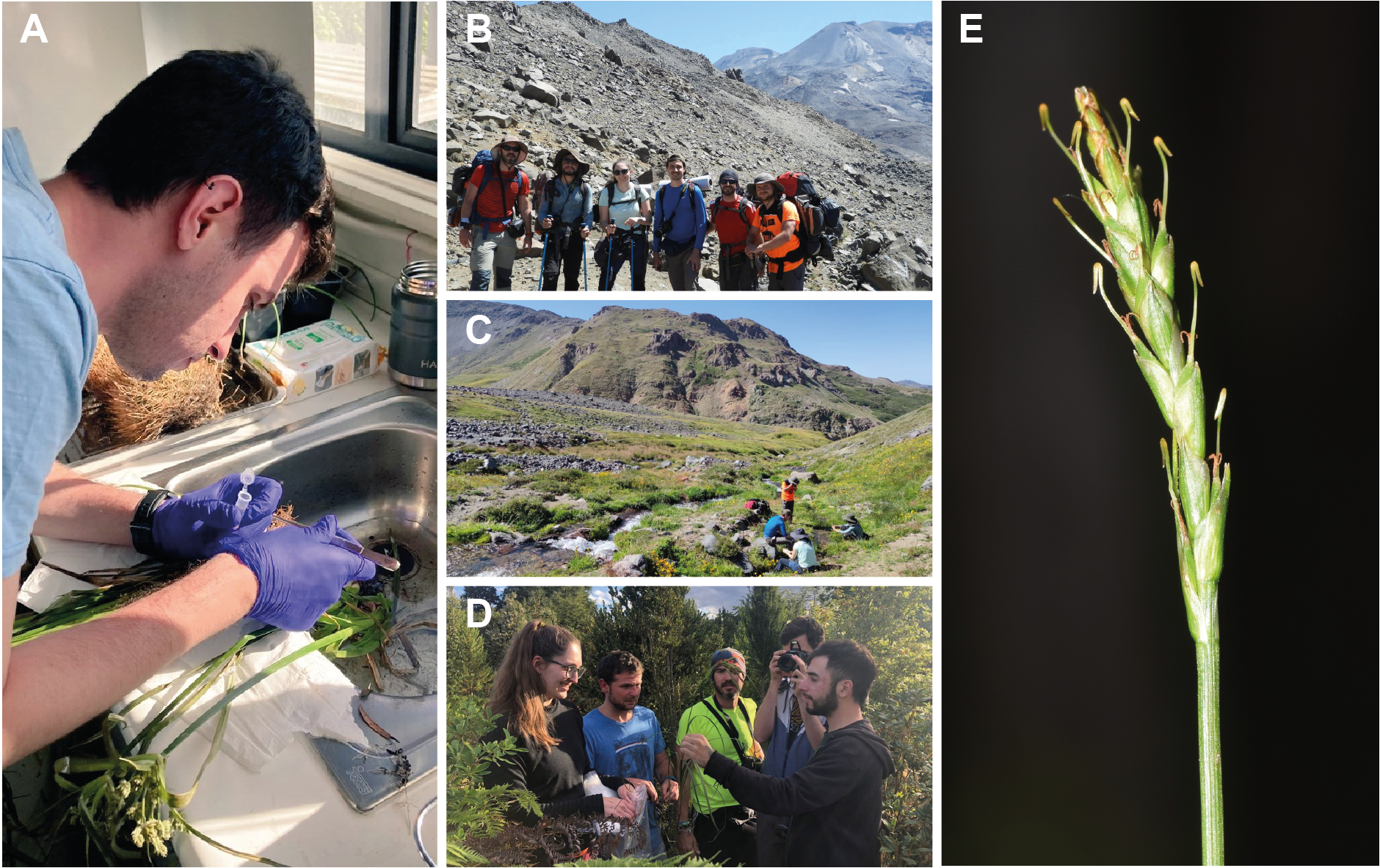2022 IAPT Research Grant
Towards an integrative study of Carex sect. Uncinia in South America: completing a mosaic of diversification processes in the Chilean Andes
2022 IAPT Research Grant (PI: José Ignacio Márquez-Corro, US$2,000)
Main colaborators: Pedro Jiménez-Mejías and Jaume Pellicer
Carex sect. Uncinia (consisting of 74 species) constitutes a remarkable case of Carex radiation within Southern Hemisphere. It is distributed across South America and Oceania. The section has two differentiated centers of diversity, one in New Zealand (45% of the section) and another in Andean South America (38% of the section). Chile is the most diverse South American country, with 71% of the American species. However, this statement is in need of reevaluation because data from South America may not be realistic due to the lack of comprehensive studies in the area. First, of the species belonging to sect. Uncinia, 94% of New Zealand representatives have been included in molecular phylogenetic studies, whilst we only have sequence information available for about 50% of the South American diversity. Second, the taxonomic knowledge of the section is scattered and incomplete, with no integrative taxonomic revision for the whole continent performed to date, and only a few local studies have been carried out until now. Such an imbalanced knowledge of the two diversity centers of sect. Uncinia seems to be due to the few collections available from South America, together with the complex morphology of the group.
Taxonomically complex groups are usually tackled using an array of approaches. Certainly, historically straightforward methods include histological studies such as those involving karyotype and genome size characterizations. New insights in the section for genome size, in combination with the chromosome numbers available up to date led us think that different ploidies may be occuring with implications in diversification. Based on that, it seems clear that it is urged to complete this “mosaic” of systematic, genomic and karyological knowledge for South American representatives. Given that Chile harbors most of the South American species of the section, a sampling effort focusing on this country seems the most reasonable start of this enterprise.
Main results
As a summary for the general project, we collected more than 400 Cyperaceae specimens, most of them belonging to 50 species of Carex, adding up to more than 1300 herbarium vouchers. Half of those materials will stay at Universidad de Concepción (CONC herbarium), and the remaining will be sent to Universidad Pablo de Olavide (UPOS herbarium) for further morphological and molecular studies. Regarding the IAPT Research Grant 2022 goal, I was able to estimate genome size for more than 200 specimens. This intensive work has resulted in the estimation of genome sizes for 50 Carex species without previous reports, as well as another ca. 15 Cyperaceae species and another 25 non-Cyperaceae species. For Carex, I have improved the knowledge of genome size by a 14% for the genus, since only 357 species (out of the 2200 species) have reported estimations so far. Regarding karyological studies, the experiments carried out in Concepción were not successful. However, seeds of the species will be grown in glasshouses to increase the chances of counting chromosomes from root meristems. Once this data is available, further conclusions can be made about ploidy and hybridization in these Carex lineages. So far, genome size has shown phylogenetic signal, with Carex sect. Uncinia having around 3pg (picograms, 2C), Flacca Clade ca. 1.5pg (2C), and the rest of the lineages around 0.7–1pg (2C).
Overall, IAPT Grant Research 2022 has allowed a considerable increase in the knowledge of sedges, especially for Chile and South America, as most of the sources for karyological and genomic data are countries from the Global North. I expect two scientific publications using the data collected using this grant.
 A. The awardee collecting root tips for chromosome counting at Universidad de Concepción (Biobío, Chile). B. The DANZ team (left to right: S. Martín-Bravo, P. Muñoz-Schüler, M. Sanz-Arnal, J.I. Márquez-Corro, P. García-Moro, and P. Jiménez-Mejías) with the Chillán volcano in the background (Ñuble, Chile). C. Team collecting sedges in Aguas Calientes (Ñuble, Chile). D. The team delighted by a Carex species in D. Penneckamp’s private living collection. E. Carex turbaria (sect. Uncinia. Los Lagos, Chile).
A. The awardee collecting root tips for chromosome counting at Universidad de Concepción (Biobío, Chile). B. The DANZ team (left to right: S. Martín-Bravo, P. Muñoz-Schüler, M. Sanz-Arnal, J.I. Márquez-Corro, P. García-Moro, and P. Jiménez-Mejías) with the Chillán volcano in the background (Ñuble, Chile). C. Team collecting sedges in Aguas Calientes (Ñuble, Chile). D. The team delighted by a Carex species in D. Penneckamp’s private living collection. E. Carex turbaria (sect. Uncinia. Los Lagos, Chile).

 Bionomia
Bionomia